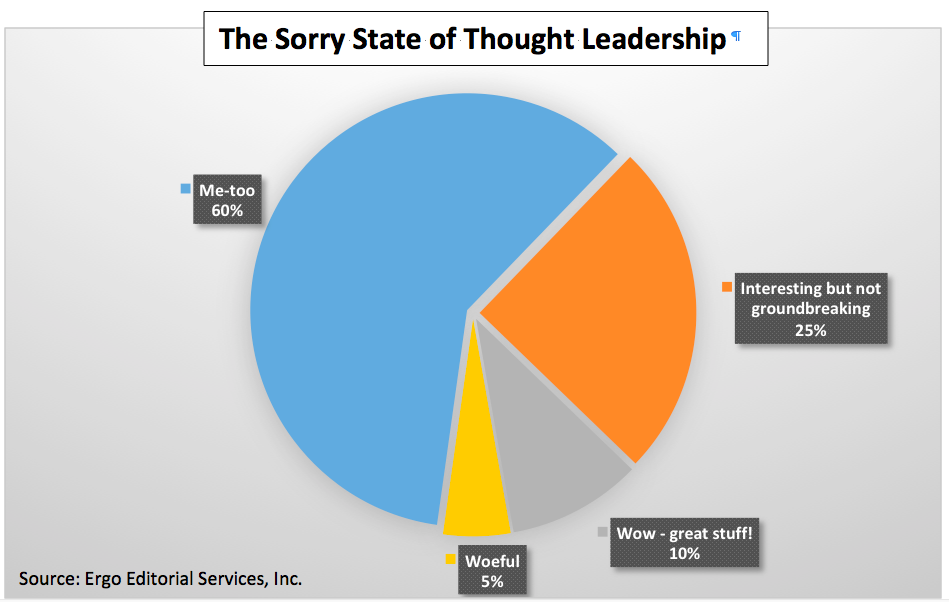Thought leadership is getting worse (so what can you do about it?)

I think the quality of thought leadership is declining.
I’ve been at this game for the better part of two decades, and I’m still seeing an awful lot of truly mediocre content. I’d go so far as to say that close to two-thirds of the articles, papers, and reports I see are “meh” – me-too stuff that says nothing new and is much the same as what every competitor is saying or has said already.
Here’s my back-of-the-envelope breakdown of the quality of content, with guide below:

- Me-too: Retread of ideas that everyone is talking about. Little that hasn’t been covered by competitors, the media, etc.
- Interesting, but not groundbreaking: Differentiated point of view backed by research and examples. Likely to help snag a client meeting.
- Wow! Forward-looking/visionary stuff packed full of fresh, insightful ideas that can be the basis of strong marketing outreach.
- Woeful: No clear point of view, poor use of English, logical inconsistencies, or all of those and more. Poorly conceived, badly written = liner for the bird cage.
That breakdown isn’t based on a massive quantitative study. It’s my opinion, based on a working lifetime in business writing. But I’m not alone. My opinion syncs with those of a more than 20 other veteran business writers and editors whom I straw-polled – folks who work in the best thought-leadership outfits, in-house and freelance.
So why hasn’t the needle moved to the right in the past 20 years or so? Here’s what I see as the main sticking points – along with my thoughts on how you can start unsticking things:
The rush to short-form: Short and fast is good. I do not pine for the days of the 30,000-word report whose thud factor was meant to say “look how clever we are.” But the pendulum has swung too far, too fast. Not everything should be “snackable.” I don’t welcome a world in which authors (and marketers) think they’ve checked the publishing box just because they’ve recently dashed off a couple of 600-word blogs.
- You can do better by planning your editorial campaigns around a portfolio of content options. No, don’t cut back on the snappy infographics and LinkedIn posts, but mix in longer papers that show your firm’s best thinking. (Check out The Guardian’s “The Long Read” https://www.theguardian.com/news/series/the-long-read.) Wired, The Economist, The Atlantic Monthly, and many other respected media brands also get big readership for their long-form pieces.
Poverty of time: Face it: your authors have a half-dozen jobs more important than developing thought leadership – not least of which is tending to their clients’ needs.
- You can do better by sharing some of the burden of thought-leadership ideation. Some top consultancies do this well, with great ideas coming from a central editorial group too. (Think The McKinsey Quarterly or PwC’s Strategy + Business.) You can bring in editorial experts who know exactly how to seed and develop thought-leadership themes. Another crucial way to take weight off your authors’ shoulders: ensure that content development is super-efficient by scoping out and screening story ideas early on, setting out clear roles and responsibilities, and proactively managing the editorial process.
Little or no internal training in best practices: At one top consultancy where I worked in-house, our editorial team hosted workshops to help the firm’s consultants understand what made for good thought-leadership writing. I don’t know of anyone who does that any more – or does it consistently. Many marketing professionals also need that best practices training.
- You can do better by understanding what’s needed to make thought leadership go right – and how it can go wrong. Set up webinars or other training forums to help promulgate editorial best practice among your subject-matter experts. (One-on-one coaching for senior partners is good too.) Better still: work with HR to build short training modules into the career development paths of your firm’s next generation of thought leaders.
Marketing mindset: So often, there’s no clear differentiation between brochureware and true thought leadership. Keen readers of this blog will have heard this refrain from me before: there’s a bright line between selling compelling ideas (= thought leadership) and selling products/solutions/offerings. Your target readers can smell a shill a mile away – and they’ll skedaddle as soon as they get a whiff of promotional content.
- You can do better by ensuring that everyone on your team not only knows the difference but can articulate it clearly. They should be able to define the term “thought leadership” – and should be working proactively to make sure that your company’s authors know the difference and grasp the respective value of each content marketing tool.
So can the quality of thought leadership improve? Yes, of course. Will it improve in my lifetime? It will, if, collectively, we push ourselves to produce the kind of thought leadership that both helps your clients and drives them to your firm to get more in-depth expertise.
Who’s with me?

0 Comments